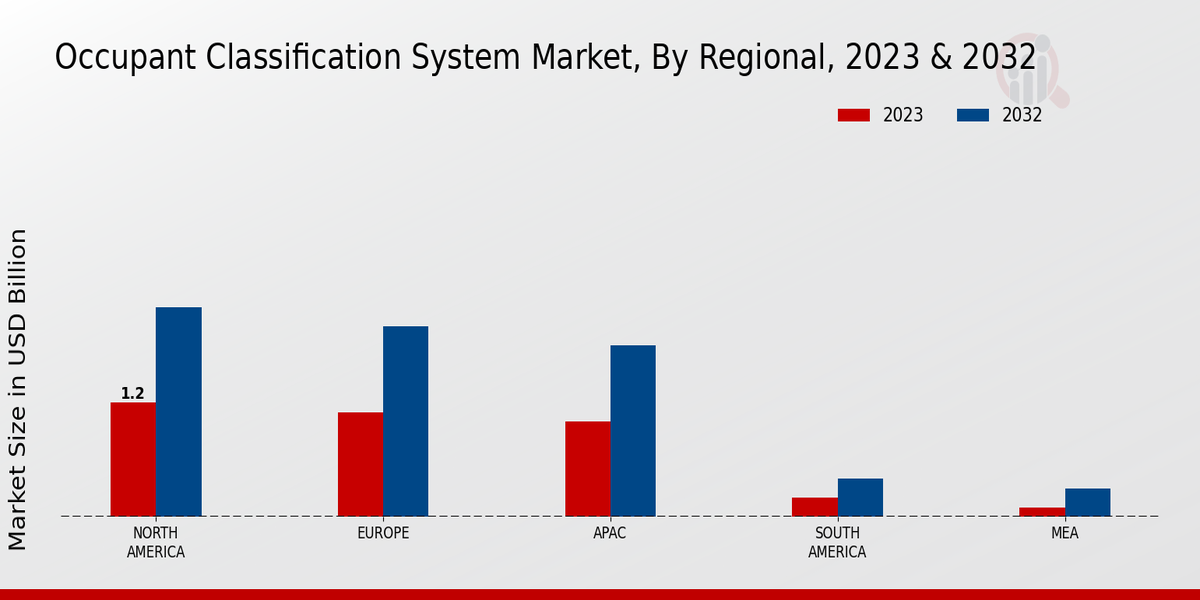Market Growth Projections
The Global Occupant Classification System Market Industry is poised for substantial growth, with projections indicating a market size of 4.18 USD Billion in 2024 and an expected increase to 8.75 USD Billion by 2035. This growth trajectory suggests a compound annual growth rate (CAGR) of 6.94% from 2025 to 2035. Such figures highlight the increasing adoption of occupant classification systems across various sectors, driven by technological advancements and heightened awareness of energy efficiency and safety. The market's expansion reflects broader trends in smart building technologies and the growing emphasis on sustainable practices.
Rising Demand for Smart Buildings
The Global Occupant Classification System Market Industry experiences a notable surge in demand due to the increasing adoption of smart building technologies. As urbanization accelerates, the need for efficient space utilization and energy management becomes paramount. Smart buildings equipped with occupant classification systems can optimize energy consumption, enhancing sustainability. The market is projected to reach 4.18 USD Billion in 2024, reflecting a growing trend towards integrating advanced technologies in building management. This shift not only improves operational efficiency but also aligns with global sustainability goals, thereby driving the growth of the Global Occupant Classification System Market Industry.
Government Regulations and Standards
Government regulations play a crucial role in shaping the Global Occupant Classification System Market Industry. Many countries are implementing stringent building codes and safety standards that necessitate the incorporation of occupant classification systems. These regulations aim to enhance occupant safety, energy efficiency, and overall building performance. Compliance with these standards not only ensures legal adherence but also promotes the adoption of innovative technologies. As governments worldwide continue to prioritize sustainable and safe building practices, the Global Occupant Classification System Market Industry is expected to expand significantly.
Enhanced Safety and Security Measures
In the context of the Global Occupant Classification System Market Industry, the emphasis on safety and security is increasingly pivotal. Occupant classification systems contribute to enhanced security protocols by accurately identifying individuals within a space. This capability is particularly crucial in commercial and public buildings, where safety regulations are stringent. The integration of these systems can potentially reduce risks associated with unauthorized access and emergencies. As safety concerns escalate globally, the demand for such systems is likely to grow, further propelling the Global Occupant Classification System Market Industry.
Growing Awareness of Energy Efficiency
Increasing awareness of energy efficiency among consumers and businesses is a driving force in the Global Occupant Classification System Market Industry. As organizations strive to reduce their carbon footprints, occupant classification systems provide valuable insights into space utilization and energy consumption patterns. By optimizing energy use based on real-time occupancy data, these systems contribute to significant cost savings and environmental benefits. The projected CAGR of 6.94% from 2025 to 2035 indicates a robust growth trajectory, reflecting the rising importance of energy-efficient solutions in the Global Occupant Classification System Market Industry.
Technological Advancements in Sensor Technologies
The Global Occupant Classification System Market Industry is significantly influenced by advancements in sensor technologies. Innovations in artificial intelligence, machine learning, and IoT are enhancing the capabilities of occupant classification systems. These technologies enable real-time data collection and analysis, allowing for more accurate occupant identification and behavior prediction. As these systems become more sophisticated, they offer improved user experiences and operational efficiencies. The anticipated growth of the market, projected to reach 8.75 USD Billion by 2035, underscores the importance of technological evolution in driving the Global Occupant Classification System Market Industry.

























Leave a Comment